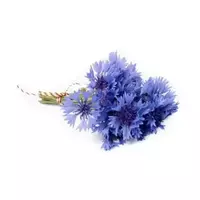Cornflowers

Sung by people in Russian folk songs, the cornflower is probably known to almost everyone. The rich blue color of the plant petals attracts the eye, and children like to weave wreaths, alternating cornflowers and daisies - the entire field is simply dotted with these attractive flowers.
It is customary to collect medicinal raw materials, which can also be used in cooking, with complete flowering of cornflowers, that is, in June-July, gently plucking edge flowers by hand, trying to prevent internal tubular flowers from entering the raw materials, which impair its quality. When dried, the cornflower petals do not smell at all, while they are characterized by a bright blue color along with a slightly bitter astringent taste.
Not only flowers, but also cornflower seeds are often used in nutrition - they are added to gravy, first dishes, seasonings or sauces. For example, to prepare a powder from cornflower seeds, they need to be thoroughly crushed, and then used as necessary.
Some like an unusual fresh salad with cornflower. It is made from cucumber grass, dandelion leaves and hare cabbage, adding some cornflower powder and dill greens, and then dressing the ready-made meal with sour cream.
Cabbage soup with cornflowers, which are prepared according to the traditional recipe for this dish, also have an extraordinary taste, but at the end of cooking, a few minutes before readiness, cabbage soup is filled with dried cornflower flowers. In addition, some meat dishes can be made with a special sauce, the recipe of which provides for the use of broth, sour cream, wheat flour, butter, tomato puree and, undoubtedly, dried cornflower flowers.
Types of cornflower
Today, there are from 350 to 500 different species of cornflower around the world, with some of them even listed in the Red Book of Russia. Among these types of cornflower are Dubyansky's cornflower, Taliev's cornflower and borovaya's cornflower.
Benefits of cornflowers
The benefits of cornflower are due to the chemical composition of their marginal flowers, in which such active substances of natural origin are present as glycosides cyanarin, chicories and centraurin, anthocyanins of cyanidine and pelargonia, flavonoids luteolin, campferol, astragalin, apiin, quercetin, cosmosiin and rutin.
The medicinal properties of cornflowers consist in their mild diuretic effect, for which tea or infusion based on this raw material is recommended for chronic diseases of the bladder and kidneys, heart and blood vessels, as well as for increasing appetite and improving digestive processes. In addition to diuretic action, the benefits of cornflowers as a natural anti-inflammatory and antimicrobial agent are known.
cornflower 0 kKal
Energy value of cornflowers (Ratio of proteins, fats, carbohydrates - ju):
Proteins: 0 g (~ 0 kCal)
Fats: 0 g (~ 0 kCal)
Carbohydrates: 0 g (~ 0 kCal)
 Español
Español Français
Français Português
Português Русский
Русский 简体中文
简体中文 繁體中文
繁體中文 日本語
日本語 한국어
한국어 العربية
العربية Türkçe
Türkçe Қазақ
Қазақ Deutsch
Deutsch Italiano
Italiano Українська
Українська
